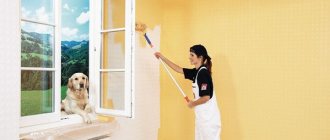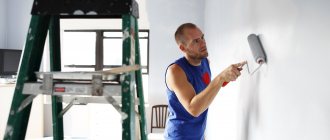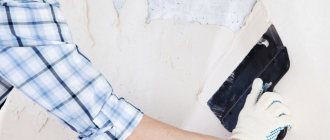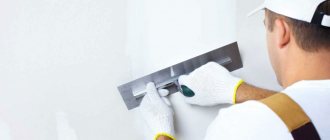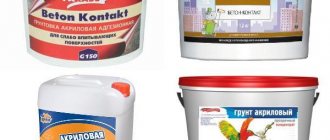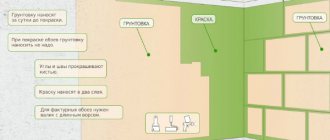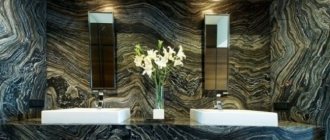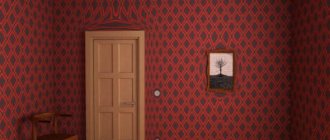Primer rating
Manufacturers of paints and varnishes produce products for interior and exterior use; they package the primer in jars from 0.5 to 20 liters. The catalogs contain products intended for specific building materials and universal compositions. When compiling the review, our experts selected products from well-known brands in all price segments for research. Performance characteristics and availability on the market were compared, and the opinions of users, professional finishers, and decorators were analyzed.
When compiling the rating, the following parameters were taken into account:
- The substrate to be treated - the materials to be painted differ in their porosity and friability. This is taken into account by manufacturers of paint and varnish products, who use additives that improve permeability and have strengthening properties;
- Adhesion – ideal adhesion should be not only to the base, but also to the finishing coating;
- Composition - to carry out repair work, you can buy acrylic, epoxy, polyurethane or alkyd primer. The drying speed, water resistance, and strength of the substrate depend on the base. The composition includes antiseptic, hydrophobic additives that change performance characteristics;
- Penetration depth varies from 1 to 40-50 mm. For porous building materials, this indicator should be at least 10-15 mm. For metal, minimum values are sufficient;
- Drying time – priming the surface is a preparatory step. The faster the primer dries, the sooner you can start painting or plastering the walls;
- Consumption - creating a substrate may require 2-3 layers - this increases costs. Single-layer application characterizes the primer on the positive side.
Not all compositions comply with SNiPs and declared characteristics. Overuse, prolonged drying, poor adhesion to the base and finishing materials - such primers were excluded from our rating.
Preparing for painting
Priming is preceded by a thorough preparatory stage.
Preparation and priming steps:
- Degreasing.
If the material is painted, the old coating is removed. The exception is colorants of the same type as the new coating. That is, acrylic paint can be used to cover old paint if it is made on the basis of acrylic. But for this it is important that the old layer is durable and does not delaminate.
Degreasing wood
For degreasing, use turpentine, acetone or universal removers. The first two products are applied with a rag 3-4 times. The resin pockets are filled with the selected solvent and blotted with a swab. Removers are used when it is necessary to remove old coating.
- Application of antiseptic.
To prevent the tree from rotting over time and becoming an abode of woodworms, the material is coated with an antiseptic primer once using a roller or a wide construction brush.
Often such mixtures contain flame retardant additives, which increase the fire resistance of the coating.
Antiseptic
- Puttying.
At this stage, they get rid of cracks and minor defects, hide seams and recesses from cutting into self-tapping screws, so that the varnish and other decorative means adhere better. When painting, it is recommended to give preference to acrylic products, which are more elastic. The composition is applied in two stages, since the acrylic product will shrink after drying.
If you plan to apply a transparent varnish to the base, then for puttying it is better to create your own composition from sawdust and PVA. This product is transparent and will not shrink after drying.
Homemade putty
- Grinding.
The procedure is performed after puttying. Movement is allowed only in the direction of growth of wood fibers. To do this, use sandpaper or a belt sander.
- Treatment with penetrating primer.
This layer is designed to increase the strength of the material, increase its adhesive properties and reduce paint consumption.
The best deep penetration primers
When performing finishing work, the finishing layer is applied to concrete or plastered surface. These materials have excellent absorbency, so the primer must penetrate deeply, bind, and strengthen the surface. The prepared base will ensure adhesion to ceramic tiles and decorative plaster, and will not allow the finishing layer to collapse in the first year of operation. Our team compared the properties of 7 deep penetration primers for concrete and recommends 3 compositions with low consumption, good adhesion.
Knauf Tiefengrund
Ready-to-use composition based on polymer dispersion. Water is used as a solvent. Penetrates deeply, forming intermolecular bonds and strengthening the surface to a depth of 10-15 mm. When using Tiefengrund, water absorption is reduced and adhesion is increased.
Used on cement and gypsum based substrates. Tiefengrund is used to treat concrete walls for painting, self-leveling floors, aerated concrete and foam concrete blocks. The polymer dispersion penetrates into the structure of drywall and plaster. A primer is used for interior work and when finishing the facade, to prepare walls for gluing with heavy non-woven wallpaper or fiberglass.
Advantages:
- Used on weak grounds;
- Dries quickly;
- Does not reduce vapor permeability;
- Low consumption;
- No unpleasant odor;
- Low price.
Flaws:
- Not detected.
Good penetrating ability allows Tiefengrund to be used effectively on finely porous chalk-based substrates. Penetrating into the structure, the primer enhances strength and allows water-based paint, wallpaper or decorative plaster to be applied to the treated surface. This expands the scope of application of chalk bases.
Glims Prime Primer
The finely dispersed acrylic primer with deep penetration does not have an unpleasant odor, which makes application comfortable indoors. Antiseptic antifungal additives have been added to PrimeGrunt. The solution is ready for use, can be used for walls and horizontal surfaces. Absorbs into different grades of concrete, stone, cement plaster and brick. As a result of polymerization, it forms bonds that strengthen the surface.
It has adhesion to wallpaper paper, paint and varnish coatings, and finishing putties. Application helps reduce glue and paint consumption. When processing the screed, it does not form a film, and the surface is well removed from dust. Forms a layer that reduces water absorption of the treated building material.
Advantages:
- Provides uniform coloring;
- Low consumption;
- Abrasion resistant;
- Dries quickly;
- Suitable for outdoor use.
Flaws:
- Not detected.
Optimist G 107
The pigmented acrylic-based composition is pink, which helps control the amount of work done. A special feature is the presence of antifungal antiseptic additives. After drying, it forms a durable layer with good adhesion to finishing materials, in which fungus or mold will not settle. Environmentally friendly raw materials are used in production, and the use of water as a solvent allows the walls to “breathe.”
It is deeply absorbed into the structure of concrete, cement plaster, brick, forming strong bonds. Can be used to treat wood before painting. Used for interior work. The solution is applied not only with a brush or roller, but also with a sprayer.
Advantages:
- Low consumption;
- Drying speed – 2 hours;
- Inexpensive;
- Improves the water resistance of building materials.
Flaws:
- Unpleasant odor of antiseptic additives.
Types of mixtures
The purpose of primer mixtures can vary significantly. Manufacturers offer deep penetration compositions that penetrate deep enough into the wall material and close the pores, and special ones. Special water-repellent materials help prevent exposure to moisture. To increase the adhesive characteristics of the base, a special primer is used. Anti-corrosion prevents metal corrosion, antiseptic prevents the appearance of mold and mildew. A fire-prevention primer, which is traditionally used for treating wood, helps reduce the flammability of metal. There is also a division according to the type of main component and purpose.
By composition
The main varieties include:
- Mineral, which is the most widely used. It is based on natural ingredients. Most often, cement is used as a binder. Can be applied to almost all substrates. The main advantages include durability, resistance to sunlight, moisture resistance;
- Acrylic. Contains acrylic polymers. Refers to deep penetration compositions. After application, it securely bonds wood fibers and is suitable for concrete and brick. Allows you to form a durable coating that increases the service life of the base. Water-based compositions are intended for preparing walls before painting walls with water-based paints;
- Alkyd. It has a complex composition. Includes polyurethane, polyvinyl chloride, polystyrene, various additives. The composition cannot be classified as environmentally friendly. Additionally, some brands require a minimum of 12-16 hours to dry. Its main advantage is the increase in the anti-corrosion properties of the base. Suitable for processing various substrates, including glass and metal;
Attention! Varieties of alkyd primer are enamel, polyurethane and glyphthalic compositions.
- Epoxy. The base is a resin, to which special chemical components are added. The coating, formed according to all the rules, provides reliable protection of the base from moisture, mold and mildew. Not afraid of significant temperature fluctuations or mechanical stress. With its help, walls are prepared in the bathroom, toilet and kitchen. It is often used to prepare various metal elements on the wall surface for subsequent painting.
- Silicone. Allows you to form the most durable primer coating. With its help, it is possible to increase the strength and adhesive characteristics of the base. As a result, the reliability of adhesion between the finishing material and the wall is significantly increased. Especially if paint on a similar basis is chosen as a finishing material. Given its composition and characteristics, silicone primer is most often used for preparing building facades. After its treatment, the walls are reliably protected from harmful negative influences;
Attention! Due to the increased toxicity of the composition, silicone primer should be applied only in PPE.
- Silicate. The basis is potassium liquid glass. With its help, the walls outside the building are most often prepared. Suitable for concrete, brick and plaster bases. Due to its structure, it allows the treatment of wet surfaces. Often used to protect walls in underground utilities;
- Quartz. The main component is quartz sand. Due to this, the formed coating significantly increases the adhesive characteristics of the base. The formed coating has a characteristic color. The quartz sand particles included in the mixture provide a unique proportion between absorbed and reflected light. With the correct selection of the finishing coating, it is possible to achieve a unique decorative effect;
- Phosphate. Designed specifically for the preparation of metal substrates. It includes many components, the main purpose of which is to increase the anti-corrosion properties of the metal base. After its application, metal surfaces acquire a characteristic shine. Before use, an acid solvent is added to the phosphate primer, which is supplied along with the base composition;
- Shellac. A specific variety consisting of the milky juice of insects and methyl alcohol. Designed specifically for processing wooden bases. Ideal for lubricating cuts on boards and timber. After processing, there is no need to worry about the appearance of wood resins at high temperatures. This negative phenomenon is often found in saunas and steam baths. The composition is applied before subsequent treatment of the base with a water-soluble stain;
By purpose
The base material may also vary. Manufacturers offer primers for:
- Tree. After priming the surface, it is possible to significantly reduce the degree of absorption of finishing compounds, reduce the risk of rotting and the appearance of pests in the wood. The composition is applied in several layers. The choice can be made in favor of an acrylic, mineral, oil primer of a light color;
- Metal. The introduction of special additives increases the level of corrosion protection even during long-term operation in conditions of high humidity. Predominantly phosphate or shellac primers are used;
- Plasters. The plastered surface absorbs moisture well and is resistant to mechanical stress. The primer contains special components for gluing the components of the base, increasing its antibacterial and water-repellent properties;
- Various reasons. Such universal primers are used for the preparation of fiberboard, chipboard, OSB boards, plywood, plasterboard and other materials.
- Concrete. For such a base, concrete contact is predominantly chosen. It is based on latex, silicate, liquid glass or bitumen. After treatment with a similar composition, the concrete surface is well protected from moisture penetration.
The best all-purpose primers
Universal compositions can be used for most types of finishing work. With their help, they level out the water absorption of substrates and improve adhesion before gluing all types of wallpaper, applying paint, gypsum and cement plasters. They use the best universal primers when preparing walls for facing with ceramic tiles and installing self-leveling floors. VyborExperta.ru recommends two brands that are characterized by low consumption and easy application.
Prospectors universal
The primer is intended for use indoors and outdoors, applied to walls, floors and ceilings. Has adhesion to concrete, cement plasters, gypsum. The base is a polymer dispersion to which antiseptic additives are added. After processing, uniform setting of gypsum and cement putties is ensured, and the adhesion strength of the substrate to the finishing material increases.
When processing the screed, the spreadability of self-leveling floors improves and the surface is removed from dust. The high latex content allows you to increase the strength of the base and improve its resistance to high humidity. Can be applied using a pneumatic sprayer.
Advantages:
- Regulates absorbency;
- Economical consumption;
- Drying time – 1 hour;
- Transparencies;
- Several types of packaging.
Flaws:
- Not intended for metal surfaces.
Unis universal
The products of the Russian company are supplied in cans made of durable plastic, which ensures safety during transportation. The polymer composition has good adhesion to concrete and gypsum bases and can be used to level out the water absorption of brick and natural stone before painting. It is used outside and inside buildings.
It has dust removal properties and is used to prepare the base before applying self-leveling floors. Helps reduce water absorption of the treated surface. Transportation in winter is allowed - the solution can withstand 5 freeze-thaw cycles without deteriorating performance characteristics.
Advantages:
- You can apply the second layer after 30 minutes;
- Increases the service life of finishing materials;
- Inexpensive.
Flaws:
- Only two types of packaging.
Types of surfaces
As a rule, when performing repairs, drywall, plaster, and wallpaper are painted for painting. Despite the fact that plaster is a moistened coating, ready for subsequent finishing work, experts recommend priming it before applying paint. This is due to the fact that the surface treated with a primer will not crack or crumble, thanks to the strengthening polymer components.
In addition, plaster is a porous material that can absorb a lot of liquid and therefore priming will help reduce the consumption of paint material.
The best primers for wallpaper
Wallpaper manufacturers offer collections on vinyl and non-woven bases, which are distinguished by their unique aesthetics. A special feature of this product is its high density. The weight of the roll is 5-6 times greater than the weight of paper wallpaper. This places increased demands on adhesive adhesion. A transparent or white primer for the wallpaper will help ensure reliable adhesion, which will not have a negative effect on the finishing coat. We offer two brands with low consumption and short drying time.
Ceresit CT 19 Betonkontakt
A German company has developed a primer for weakly absorbent concrete substrates, which improves adhesion to wallpaper and tile adhesive. Ceresit CT19 is designed for processing vertical surfaces. During production, fine-grained quartz sand is used, which makes smooth walls made of monolithic concrete rough, providing adhesion. The fraction is controlled by automated equipment.
The base is an acrylic emulsion, which is vapor permeable. This is an environmentally friendly material that can be used in bedrooms and children's rooms. Apply to walls with a roller or brush.
Advantages:
- Economical consumption;
- There is no unpleasant odor;
- Reliably fixes wallpaper on the wall;
- Variety of packaging options;
- Has antiseptic properties.
Flaws:
- Minimum drying time 3 hours.
Tex concrete-contact Universal
Made on an acrylic base with the addition of fine quartz sand. Designed for processing smooth concrete, drywall and plaster painted with alkyd paints. Provides a high level of adhesion to tile and wallpaper adhesive. The sand used in the formulation is very fine and does not provide good adhesion to a thick layer of heavy cement mortars, but the grains do not show through thin paper wallpaper.
The ready-to-use solution is applied with a roller or paint brush. Water is used as a solvent, which guarantees the vapor permeability of the formed film. A distinctive feature of the primer is a large percentage of dry residue, which reduces consumption.
Advantages:
- Minimum drying time – 1 hour;
- Can be used for facade finishing;
- Different packaging;
- No unpleasant odor.
Flaws:
- Not detected.
All about priming walls
Why apply primer?
Types of primer mixtures
Special means
Drying times for preparations
Calculating consumption
We prime correctly
Once the renovation is complete, you want the results to last for a long time. But, unfortunately, this does not always happen. Neglecting the technology of work leads to the fact that after a short time the painted walls begin to crack, the coating peels off and falls off. To prevent this from happening, proper priming of the walls before painting is necessary. Let's figure out how to do everything right.
The best primers for painting walls
Interior paints help create an atmosphere of comfort and coziness in a room; hundreds of shades allow you to choose materials for exclusive projects. A smooth surface is required for repairs. You can create the perfect base using a primer for painting walls. The composition will improve the structure, ensure uniform absorption of fine paint, and help reduce consumption.
Interior varnish with anti-mold additives
A special feature is its good penetrating ability: it strengthens loose building materials and evens out absorption. The ready-to-use solution is created on an acrylic base, the solvent is water. The formulation uses fungicidal additives that prevent the appearance of mold on slopes and in places with high humidity.
Has adhesion to cement plasters, monolithic concrete, brick. Reduces interior paint consumption by 10-15%. The composition is frost-resistant and can withstand up to 5 cycles of freezing and defrosting. Apply to vertical and horizontal surfaces.
Advantages:
- Low consumption;
- Structures the surface;
- Does not have an unpleasant odor;
- Lays flat on the base;
- Low price.
Flaws:
- Minimum drying time 3 hours.
Tikkurila Valtti Expert Base highly effective bioprotective
Finnish wood primer will help preserve the natural beauty of a façade made from natural materials. Good penetrating ability allows you to process wood with humidity up to 40%. The composition evens out absorption, façade and interior paint applies smoothly, without stains with different shade saturations.
Contains fungicidal additives that protect against mold, rot, blue stains, and fungus. This preserves the decorative qualities of the finish and extends the service life of the materials. Apply to vertical, horizontal, embossed surfaces. Prepares a substrate with good adhesion for alkyd and water-based paints.
Advantages:
- Convenient packaging;
- Drying time 1 hour;
- Water based;
- Environmental friendliness;
- Fits well.
Flaws:
- Apply with a brush only.
Pufas betokontakt BC for interior work
A universal composition with good vapor permeability, which can be used for finishing inside and outside a building. It is used in rooms with high air humidity, for priming facades and plinths of buildings. It applies not only to concrete and brick, but also to waterproof plywood and OSB boards. Apply to vertical and horizontal low-absorbent surfaces.
Contains fine quartz sand, which forms a rough substrate with good adhesion to paints and varnishes. A blue indicator helps visualize areas that have been treated. Drying time 4 hours.
Advantages:
- Does not contain organic solvents;
- Can be applied by spray;
- Good adhesion to foam;
- Convenient packaging;
- Frost resistance.
Flaws:
- It takes a long time to dry.
Is it possible to paint without a primer when it is necessary to apply a primer?
A primer before painting may not be used in cases of gluing wallpaper and then painting it, as well as after finishing with latex putty, which does not crumble during use.
The need for primer is established in cases where it is necessary to paste wallpaper. This allows you to securely adhere them to the walls. Plasterboard sheets must be primed with the substance. Plaster is used if you need to repaint old paint in a new tone, which helps neutralize the show-through of the previous finish.
Plasterboard sheets must be primed with the substance.
By priming any surface before painting, you make further finishing work easier. This contributes to better distribution of the paint layer and a reduction in consumables, which can save significant financial resources.
The best primers for exterior use
Facades and small architectural objects are subject to constant aggressive climatic influences. A primer for external use will help extend the life of paint and decorative plaster. These compositions form films that do not lose their characteristics under sudden temperature changes, frost, or exposure to solar ultraviolet radiation.
Pinotex Base
Designed for processing wooden facades, platbands, cornices, railings. It has good penetrating ability, allowing the absorption of areas with different densities to be equalized. Provides uniform coloring. Contains fugincidal additives that protect wood from rot and fungi.
It is made on the basis of white spirit solvent; when using decorative impregnations Pinotex, it guarantees double protection of wood from adverse external factors. Apply with a brush, drying time 24 hours. Forms a matte decorative film.
Advantages:
- Protects deep layers of wood from rot;
- Increases the service life of the facade;
- Saves finishing coatings;
- Increases the interval between repairs of facades;
- Low price.
Flaws:
- Strong smell.
Olsta Exterior Primer
Colorless composition with perfect adhesion to any mineral substrates. It is characterized by deep penetration into the structure, impregnates the top layer, strengthens it, forming bonds at the intermolecular level. Evens out the absorbency of concrete, brick and plaster.
The base is an acrylic dispersion that forms a film with good vapor permeability. The recipe meets the requirements of environmentalists; the company strictly controls the raw materials used and does not allow materials containing harmful substances into production. Can be used on surfaces painted with acrylic paint.
Advantages:
- Low consumption;
- Dries in 2 hours;
- Apply by brush and roller;
- High adhesion to textured decorative coatings.
Flaws:
- Overcharge.
How to properly prime walls - the process itself
- From the very beginning you need to prepare the surface. Using a spatula, remove all excess, remove everything that falls off or crumbles.
- We remove large debris and vacuum the floor. It is advisable to vacuum the wall. But you can just sweep the dust off it. If the vacuum cleaner is a household one, there is a possibility of rapid clogging and breakdown!
- Cover everything you need with film and paste it with masking tape so as not to prime the floor or furniture.
- If the soil is deeply impregnated, then read the canister to see if it needs to be diluted with water. Pour into container.
- Use a brush to coat all corners and junctions.
- Then roll out the roller well so that it does not drip. Roll the soil onto the wall from bottom to top with a roller. We roll out the drips well, try to ensure that the wall is primed evenly and there are no drops!
- If the surface is very bad and crumbles, then prime it again after an hour.
The primer after filling the walls should be done as carefully and evenly as possible. The resulting smudges can be visible even through the wallpaper, not to mention painting. Priming under plaster can be done less carefully.
As for the adhesive primer (putzgrund), it can be applied with a large brush using movements in different directions. If the primer is of high quality, for example Caparol putzgrund 610, then it can be applied with a roller. Roll out like paint in an even layer without smudges. If the surface is loose and dusty in places, then apply a deep impregnation primer before the sandy primer. And after complete drying the putzgrund.
The primer must dry well, preferably 24 hours! The composition should not just dry, but polymerize. Never start working while the ground is wet.
How to choose a primer
Before purchasing, you need to figure out which primer is for wallpaper and which is intended only for wood. In addition to the purpose, you need to get acquainted with the composition - this will help you choose a material that is comfortable to work with in enclosed spaces. When treating weak substrates, penetration depth becomes an important factor. You need to pay attention to additional properties and drying time. This will help you understand which primer is most suitable for the planned repair.
Purpose
The primer must be designed to be applied to the substrate to be treated. This is due to different absorbency requirements. Compositions for concrete, plaster, and wood must penetrate inside and close all pores, providing a noticeable reduction in paint consumption. The GF metal primer should remain on the surface and form a thick protective layer that prevents corrosion.
Not all compositions are universal and have the same adhesion to different mineral substrates. Smooth concrete, dense drywall, and chalk plasters are complex surfaces that require specialized components to adhere to them. The scope of application must be indicated by the manufacturer on the label.
Compound
The main component affects the main characteristics: adhesion, strength of intermolecular bonds, water resistance, resistance to solar ultraviolet radiation. According to reviews from builders, primers based on acrylic dispersion have universal properties. These solutions are low priced, environmentally friendly, and have excellent adhesion to mineral substrates. Polyurethane-based materials are distinguished by their high strength, resistance to abrasion and aggressive chemical reagents, but their price is 2-3 times higher.
The composition influences the choice of solvent. Water-soluble materials do not have a strong odor and are convenient to work with in enclosed spaces. Products based on organic solvents dry quickly, but require compliance with safety regulations: the room must be ventilated. These primers are best used outdoors.
Manufacturers add components that expand the functionality of the product. These are antiseptic, antifungal additives and components that improve the water resistance of the forming film. The information is relevant when choosing a primer for rooms with high humidity.
Penetration depth
The characteristic is relevant for porous substrates. The deeper the solution penetrates, the more pores are filled. This provides increased strength, minimizes paint or glue consumption, and makes adhesion to decorative plaster better and more durable. Deep penetration compositions fill pores to a depth of 10-15 mm, for weak bases this value reaches 20-25 mm, for dense bases - 5-10 mm. This parameter is taken into account when choosing a primer material for plaster, screed, concrete and wood. The penetration depth for metal primers does not matter.
Drying time
Surface priming is an intermediate operation on which finishers do not plan to spend much time. It is recommended to give preference to solutions that dry within 1-2 hours. The crew can spend this time eating lunch and continue painting, tiling, or wallpapering when it’s finished. If the primer dries within 3-4 hours, then it is better to use it on large areas or when there are parallel tasks in other areas of the construction site.
Properties
Primers are produced with different properties - strengthening, universal, concrete contact, antiseptic. The functionality is expanded due to polymer modifying additives. When choosing, you need to take into account the tasks being solved. Strengthening agents are intended for weak porous building materials. Penetrating into the structure, they form bonds that increase the strength of the surface layer. This makes the clutch stronger and increases the interval between scheduled repairs.
Universal primers are relevant when processing various building materials indoors and outdoors. Concrete contact is designed to improve the roughness of surfaces made of monolithic concrete and arched structures. Its recipe uses quartz sand. When choosing, the composition of the fraction is important, which depends on the purpose. Small grains are used for primers for wallpaper or painting. Larger fractions are relevant when plastering walls.
How to calculate the cost of funds
To determine the approximate amount of material, simple calculations should be made. First, we determine the area that needs to be primed. This can be done by multiplying the height of each wall by its length and then adding the results together. It is important to remember to subtract the area of doors and windows. We should have a certain number of square meters.
Now we determine the rate of consumption of the product. It must be indicated on the packaging. It is rare that in such a case there will be only one number. More often a small fork of values is shown. This is due to the fact that different types of base absorb differently. Knowing what kind of coating we have to work with, we select a number and multiply it by the previously calculated number of squares.
We decide on the number of layers. If you need one, all you have to do is multiply the result by a factor of 1.15 to get some supply of material. In the case when it is supposed to apply two or more layers of primer, we multiply the calculated value by their number, and then by the coefficient. This way we get an approximate amount of primer, which we focus on when purchasing.
Instagram art_remont_stas
The required amount of primer depends on the type of base, the number of its layers, absorbency, etc.
- Decoration Materials
How to paint wet rooms: tips and life hacks
Which primer is better
Surface priming is used at different stages of finishing and facade work. Wood, metal, concrete, plasters and gypsum blocks are processed. Which primer should I choose for walls, and which one is better for installing a self-leveling floor? To solve these problems, it is better to use different brands of primers. All products from our rating are available in Russia. The VyborExperta.ru team recommends using the following compositions from our review:
- Knauf Tiefengrund - for working with gypsum and chalk;
- Glims Prime Primer – for plastering on porous surfaces;
- Unis universal – for multifaceted work outside and inside the building;
- Ceresit CT 19 Betonkontakt - choice for gluing heavy wallpaper;
- Pufas betokontakt BK – for painting walls;
- Tikkurila Valtti Expert Base – for facade woodwork;
- Olsta Exterior Primer – primer for exterior finishing of buildings.
Surface priming is a mandatory technological stage when performing finishing work. The best compositions will help reduce the consumption of expensive finishing coatings and increase the strength of the decorative layer.
Priming different surfaces, answers to questions
Different surfaces are primed using the same technology, or with a brush or roller, depending on the curvature of the surface. For example, a brick wall is quite difficult to prime with a roller, so the entry point is a large brush.
Do I need to prime the walls before plastering? Necessarily! To improve adhesion to the surface. And if the wall is made of smooth concrete, then we must prime it with concrete contact (adhesive composition).
Do I need to prime the walls before applying putty? Before any type of finishing, you need to prime the surface and wait until it dries completely.
Does drywall need to be primed? Drywall also needs to be impregnated with soil. Its technical characteristics are improved, the surface becomes an order of magnitude stronger. According to the technology for finishing gypsum boards, a mandatory procedure is the priming of non-factory seams; only after complete drying can you begin to putty them.
Here's the most basic information you need to know about properly priming walls. We will talk about other types of surface priming in other articles.
General information
Should I prime before painting?
The priming process can be carried out with various compositions - paint, which is prepared with a primer preparation or a concentrate, which is diluted according to the instructions. The solutions will also be marked relative to the surface to which they will be applied (metal, wood or plaster).
Types of solutions
Water-based
Paint such as water-based emulsion is far from the cheapest material for finishing, and therefore preliminary priming of walls makes it possible to significantly save on the consumption of paint and varnish material. The primer composition, which is applied under water-based paint, reduces the hygroscopicity of the base, and this leads to a more uniform distribution of the paint and varnish material on the surface, and also increases the strength of the coating and increases wear life. The primer for the water-based emulsion is applied with a brush, preferably in one layer, which should ideally cover all the unevenness of the walls, but not create uneven accumulations of primer. After the primer composition has completely dried, which takes from 5 to 7 hours, the water-based paint should be applied in two layers.
Silicate
Silicate-type paints are sold dry; to paint mixtures, they should be diluted with water and applied within a short time until the paint loses its properties. For this reason, pre-priming with a silicate base is incredibly important for the speed and quality of the paint job. Special primer compositions make it possible to reduce the toxicity of alkalis contained in silicate-type paints, as well as strengthen mineral surfaces to increase the service life of the paint up to 15 years.
Acrylic
Priming before using acrylic paint has an incredibly important feature - the composition should be applied to highly abrasive surfaces, because it will gradually begin to slide off smooth ones even with paint. For this reason, before applying the primer, the wall surface should be treated with a stiff brush or coarse sandpaper to artificially create grooves and roughness. In turn, the priming solution perfectly fixes the coating particles, and also evens out the adhesive properties and absorbency of the wall surface, which will allow the acrylic paint to lay down evenly, in a durable layer.
Oily
Oil-based paint is one of the best in terms of adhesion, even without applying a preliminary layer of primer. It is this process that will increase the strength of the oil-type coating, and make it smoother and less porous. But often oil paint, which is applied without a primer, will itself act as an unsurpassed material for finishing work, as it adheres well to the surface. When initially applying oil paint, it is not at all necessary to prime the walls before painting. When recoating, it is worth choosing a special “on top of the paint” composition, which will make it possible to save the time needed to remove the old layer.
